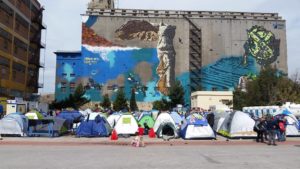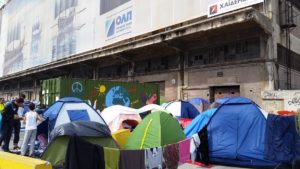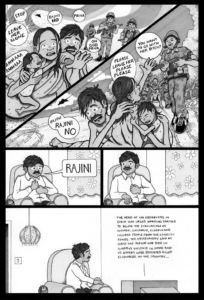
This comic is of Ethiopian refugees traveling on foot at night and trying to not to get caught from patrol by whispering and only opening their eyes slightly.

This comic is of Ethiopian refugees traveling on foot at night and trying to not to get caught from patrol by whispering and only opening their eyes slightly.






These are some photos I captured when I volunteered at a refugee camp in Piraeus, Greece in 2016.

This is a comic saying that we are a welcoming country but then saying Don’t come.

This comic sees him having a flashback of his experiences of the conflict of his escape from Sri Lanka.
The condition in Togo in regards to the economy and the government has improved only a little but still needs work. The current president of the country, who entered into office in 2005, has not really done much to better the country since his father passed the presidency to him. The state of the country doesn’t seem to be getting better at all and many times people seek refuge in the neighboring countries such as Ghana or Benin. This article “Refugee Politics: Self-Organized ‘Government’ and Protests in the Agamé Refugee Camp (205-13)” talks about the different forms of representation and participation set up by the Togolese refugees in the Agamé camp in Benin between 2005-2013. It also examines the protests about their statutory rights during this period. In this article, the people who moved to the refugee camp in Benin were unsatisfied because the strategies that were put in place by the United Nations High Commissioner for Refugees (UNHCR) and other organizations running the camps would set them up, withdraw form them, and then eventually dismantle them therefore leaving the refugees without any real help. The reason why the camp was created in the first place was to be cope with the influx of Togolese refugees into Benin after the election of the current president. It quickly became an issue because the refugees wanted representative structures that would allow them to interact with the UNHCR and the Benin administration but unfortunately it did not work. Eventually in 2013, Benin authorities evacuated the camp in order to end the continued existence of Togolese in a camp where the organization who set it up had left several years before.
Is Mexico really choosing to help for political reasons? My previous article talked about Mexico “helping” the united States with the amount of refugees for political reasons to not hurt Mexico’s and United State’s relationship. Though I found a new article from Mexico News Daily saying that it is not for political reason. The article, “Mexico Rejects US plan to extend ‘stay in Mexico’ policy for asylum seekers”, starts with announcing that Mexico does not agree with with the United States plan for refugees to stay in Mexico while they wait for approval to migrate to the US. They continue by saying the Mexican government is trying to help them by taking in returned refugees who were in dangerous border cities. They went to coordinate with the United states to help their people not to only please those in the politics. This article was also posted after the New York Time’s article and even quotes it themselves to try and further push their evidence to their point.
It is not fully disagreeing with the New York Times article, but it does say that the New York Times had things thought to be happening for the wrong reasons. Mexico News Daily is also unbiased and using strong emotional words. Again, in the headline this article uses the word “rejects” maybe not the strongest emotional word, but they could have used something more milder like deny, which to me seems less intense. I also believe the image they use in their headline on the page is more emotional and close to a false connection. It is related because it is migrants marching, but it is all black and white except for the family, has lots o children who look exhausted carrying heavy things across a dirty train track. That just screams “give us empathy”. SO both the articles I had were defiantly biased in a way.
Article Link: https://mexiconewsdaily.com/news/mexico-rejects-us-plan/
Is Mexico not allowing their citizens move to America? The article I chose from the New York Times: “Trump’s Surprising New Ally in Mexico? The Government” informs their readers about Mexico and their role in immigration. They discuss that Mexican authorities are preventing asylum seekers and refugees from migrating to the United States before they even reach the border. It also discusses Mexico’s new president’s, Lopez Obrador, role and he is currently choosing politics so he does not threaten his relationship with Trump and the United States. The articles also reviews the issues happening, for example the people who get stuck between the cities who are allowing entry and who are not or the people in danger in unfamiliar areas. Also, Trump wants asylum seekers to stay in Mexico while they wait for approval and the people try to flee the danger in their home are stuck their waiting with worry.
The New York Times is a relatively centered and credible, but they still use emotional words. A major one is in their headline, they use the word surprising in reference to Mexico potentially helping the United States. It is already swaying your thoughts with theirs that it should not be expected of Mexico. It also uses strong words like “violating”, “jeopardizing”, and “fleeing”. One strong paragraph said: When they begin talking about Tijuana, they talk about how “the Trump administration has plunged” asylum seekers and that they are “forcibly” sent, and then continuing to say “killings int Tijuana have skyrocketed“. The authors of the article could have used less strong, emotional words, to stay more centered in biases.
Article Link: https://www.nytimes.com/2019/03/01/world/americas/mexico-migration-trump.html
This article posted on March 9, 2019, reports on the continued separations of families seeking asylum. It covers the basics of the family separation policy, it’s dissolution, and it’s continued existence despite the policy having been officially rescinded. The article lists the number of families separated, the growing numbers, the ramifications on both children and parents, and the political ramifications. This program worked largely without proper oversight and has been proven to be traumatic to the children. The article continues, giving detailed mini-chronicles of some of these family’s stories. The Customs and Border Protection officials claim all current separations are legal under current law, though in fact they are separating families for minor and often outdated crimes that have been resolved already. Many of the separations are done without any justification to the point where the Health and Human Services Department’s Office of Refugee Resettlement has started trying to refuse to take the children separated by the policy. Records have been kept so poorly that there are many accounts of parents being told that no one knew where thier kids were, children have been separated from parents and sent all over the country with little to no proper records or oversight. Children from newborns to teens have been relocated, with little explanation and are scared, confused, and lost in a strange country with strange people and no adults that they trust. One young woman, age 18 was so distraught by the separation of herself and her two younger siblings from thier mother that she had to be hospitalized for threatening suicide. It has gotten so bad that the American Civil Liberties Union have had to intervene, demanding that the missing and children be found. This situation has not been resolved as of this article’s publishing.
The article I chose as an opposing view of the Washington Post article is from NPR. This article creates a simple and seemingly unbiased presentation of part of the recent budget plan proposed by the Trump administration. This plan included cuts to the United State’s immigration services, especially those based in other countries. This article explains that the plan could save millions of dollars, but could also slow down refugee processing, family reunifications, and military citizenship applications. The article then goes on to explain that the United States Citizenship and Immigration Services agency could possibly outsource their work to U.S. embassies and consulates abroad as their department is cut back and offices are closed. A policy analyst at the Migration Policy Institute stated that the plan will likely lead to further processing strain for refugee applications.
This article utilized simple language that carried little to no emotional influence while presenting the facts of the topic. Much of the article consisted of direct quotes and exact descriptions of the actions of the analysts and agency heads involved. All information presented was relevant, well connected, and used in the correct context. There was no excessive use of adjectives, which can be seen in biased articles as a tool to sway a viewers opinion. This article seems to be a factual and trust worthy piece of news because of its attention to detail, straightforward language, and unbiased portrayal of a national concern.
Article:
https://www.npr.org/2019/03/12/702807908/trump-administration-seeks-to-close-international-immigration-offices
The article I chose highlights the recent attempt of change in policy by the President on the amount of refugees allowed to enter the country by adjusting the cap to about 30,000, the lowest since the U.S.’s refugee program’s creation. The article states that the new policy is not to allow most refugees in to the United States, which is to be accomplished by cutting international humanitarian aid and cut back within the Bureau of Population, Refugees and Migration. The new budget for this department would be slashed from 3 billion to 320 million dollars. Aid for hunger and natural disaster relief also were set to be cut back. This budget will not make it through Congress.
This article is from the Washington Post, and uses a great deal of emotional words. For example, just the title “Trump is turning his back on refugees — and America’s tradition of compassion” uses the imagery of turning refugees away in a violent manner, and suggests that Trump is as well throwing away the United States’ history of care for other countries. Throughout the article particular words are used to enhance the emotions being evoked by the reader. For example, instead of using the term “budget cut” to explain the de-funding to the Bureau of Population, Refugees and Migration, the article explains that the plan will “squash the operations nearly to nothingness”. This is a much more emotionally involved statement that utilizes imagery and strong words to create sympathy for the de-funding. Overall, this article uses factual information about the happenings of the planned budget, but has an noticeably liberal bias in the language and explanation of the administration’s plan.
Article Link: https://www.washingtonpost.com/opinions/trump-is-turning-his-back-on-refugees–and-americas-tradition-of-compassion/2019/03/14/c2ae92e8-45d3-11e9-aaf8-4512a6fe3439_story.html?noredirect=on&utm_term=.c05b918ca0b9